Northern elephant seal
| Northern elephant seal | |
|---|---|
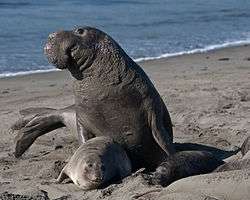 | |
| Male, female and pup | |
| Scientific classification | |
| Kingdom: | Animalia |
| Phylum: | Chordata |
| Class: | Mammalia |
| Order: | Carnivora |
| Family: | Phocidae |
| Genus: | Mirounga |
| Species: | M. angustirostris |
| Binomial name | |
| Mirounga angustirostris (Gill, 1866) | |
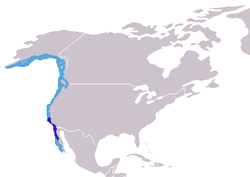 | |
| Distribution of the northern elephant seal (dark blue: breeding colonies; light blue: non-breeding individuals) | |
The northern elephant seal (Mirounga angustirostris) is one of two species of elephant seal (the other is the southern elephant seal). It is a member of the family Phocidae ("true seals"). Elephant seals derive their name from their great size and from the male's large proboscis, which is used in making extraordinarily loud roaring noises, especially during the mating competition. Sexual dimorphism in size is great: The males can grow to 14 ft (4 m) and 5,000 lb (2,300 kg), while the females grow to 11 ft (3 m) and 1,400 lb (640 kg). Correspondingly, the mating system is highly polygynous; a successful male is able to impregnate up to 50 females in one season.
Description

The huge male northern elephant seal typically weighs 1,500–2,300 kg (3,300–5,100 lb) and measures 4–5 m (13–16 ft), although some males can weigh up to 3,700 kg (8,200 lb).[2] Females are much smaller and can range from 400 to 900 kg (880 to 1,980 lb) in weight, or roughly a third of the male's bulk, and measure from 2.5 to 3.6 m (8.2 to 11.8 ft).[3] The bull Southern Elephant Seals are, on average, larger than those in the Northern species but the females in both are around the same size, indicating the even higher level of sexual dimorphism in the Southern species.[4] Both adult and juvenile elephant seals are bar-skinned and black before molting. After molting, they generally have a silver to dark gray coat that fades to brownish-yellow and tan. Adult males have hairless necks and chests speckled with pink, white and light brown. Pups are mostly black at birth and molt to a silver gray after weaning.
The eyes are large, round and black. The width of the eyes and a high concentration of low light pigments suggest sight plays an important role in the capture of prey. Like all seals, elephant seals have atrophied hind limbs whose underdeveloped ends form the tail and tail fin. Each of the "feet" can deploy five long, webbed fingers. This agile, dual palm is used to propel water. The pectoral fins are used little while swimming. While their hind limbs are unfit for locomotion on land, elephant seals use their fins as support to propel their bodies. They are able to propel themselves quickly (as fast as 8 km/h) in this way for short-distance travel, to return to water, catch up with a female or chase an intruder.
Like other seals, elephant seals' bloodstreams are adapted to the cold in which a mixture of small veins surrounds arteries capturing heat from them. This structure is present in extremities such as the hind legs.
A unique characteristic of the northern elephant seal is that it has developed the ability to store oxygenated red blood cells within its spleen. In a 2004 study researchers used MRI to observe physiological changes of the spleen of 5 seal pups during simulated dives. By 3 minutes, the spleens on average contracted to a fifth of their original size, indicating a dive-related sympathetic contraction of the spleen. Also, a delay was observed between contraction of the spleen and increased hematocrit within the circulating blood, and attributed to the hepatic sinus. This fluid-filled structure is initially expanded due to the rush of RBC from the spleen and slowly releases the red blood cells into the circulatory system via a muscular vena caval sphincter found on the cranial aspect of the diaphragm. This ability to slowly introduce RBC into the blood stream is likely to prevent any harmful effects caused by a rapid increase in hematocrit.[5]
Range and ecology

The northern elephant seal lives in the eastern Pacific Ocean. They spend most of their time at sea, and usually only come to land to give birth, breed, and molt. These activities occur at rookeries that are located on offshore islands or remote mainland beaches. The majority of these rookeries are in southern California and northern Baja California, ranging from Point Reyes National Seashore, California to Isla Natividad, Mexico.[6] Significant breeding colonies exist at Channel Islands, Año Nuevo State Reserve, Piedras Blancas Light, Morro Bay State Park and the Farallon Islands in the US,[7] and Isla Guadalupe, Isla Benito del Este and Isla Cedros in Mexico.[7] In recent decades the breeding range has extended northwards. Since the mid-1990s some breeding has been observed at Castle Rock in Northern California and Shell Island off Oregon[8] and in January 2009, the first elephant seal births were recorded in British Columbia at Race Rocks.[9] The California breeding population is now demographically isolated from the population in Baja California.[7]
Northern elephant seals exhibit extreme sexual dimorphism in their feeding behaviours. When the males leave their rookeries, they migrate northwards to their feeding grounds along the continental shelf from Washington to the western Aleutians in Alaska.[10][11] The males mostly feed on benthic organisms on the ocean floor.[10] When the females leave their rookeries, they head north or west into open ocean, and forage across a large area in the northeastern Pacific.[10] They have been recorded as far west as Hawaii.[10] Female elephant seals feed mainly on pelagic organisms in the water column.[10]
Vagrant elephant seals possibly appear on tropical regions such as at Mariana Islands.[12] Historical occurrences of elephant seal presence, residential or occasional, in western North Pacific are fairly unknown. There have been two records of vagrants visiting to Japanese coasts; a male on Niijima in 1989[13] (reference introducing a visit by a North Pacific Right Whale in 2011), and a young seal on beaches in Hasama, Tateyama in 2001[14] (where another right whale was seen in 2000). Some individuals have been observed on the coast of northeast Asia. Certain individuals established haul-out sites at the Commander Islands in the early 2000s; however, due to aggressive interactions with local Steller sea lions, long-term colonization is not expected.[15]
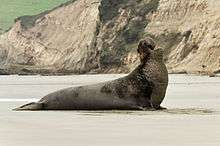
Female elephant seals forage in the open ocean, while male elephant seals forage along the continental shelf.[10] Males usually dive straight down to the ocean floor and stay at the bottom foraging for benthic prey.[10] The females hunt for pelagic prey in the open ocean, and dive deeper (up to 1000 m) and stay down longer than the males.[10] Northern elephant seals eat a variety of prey, including pelagic, deep-water squid, Pacific hake, pelagic crustaceans, sharks, rays, and ratfish.[11][16] Octopoteuthis deletron squid are a common prey item, one study found this species in the stomachs of 58% of individuals sampled off the coast of California.[17] A female northern elephant seal was documented in 2013 by a deep sea camera at a depth of 894 m (2,933 ft), where it consumed a Pacific hagfish, slurping it up from the ocean floor. The event was reported by a Ukrainian boy named Kirill Dudko, who further reported the find to scientists in Canada.[18] Elephant seals do not need to drink, as they get their water from food and metabolism of fats.
While hunting in the dark depths, elephant seals seem to locate their prey at least partly by vision; the bioluminescence of some prey animals can facilitate their capture. Elephant seals do not have a developed a system of echolocation in the manner of cetaceans, but their vibrissae, which are sensitive to vibrations, are assumed to play a role in search of food. Males and females differ in diving behavior. Males tend to hug the continental shelf while making deep dives and forage along the bottom,[10] while females have more jagged routes and forage in the open ocean.[10] Males return to the same feeding ground every year, while females have less predictable feeding migrations. Elephant seals are prey for killer whales and white sharks. Both are most likely to hunt pups, and seldom hunt large bull elephant seals, but have taken seals of all ages. The shark, when hunting adults, is most likely to ambush a seal with a damaging bite and wait until it is weakened by blood loss to finish the kill.[19]
Social behavior and reproduction

Northern elephant seals return to their terrestrial breeding ground in December and January, with the bulls arriving first. The bulls haul out on isolated or otherwise protected beaches, typically on islands or very remote mainland locations. It is important that these beach areas offer protection from the winter storms and high surf wave action.[20] The bulls engage in fights of supremacy to determine which few bulls will achieve a harem.[21][22]
After the males have arrived to the beach, the females arrive to give birth. Females fast for five weeks and nurse their single pup for four weeks; in the last few days of lactation, females come into estrus and mate.[23] In this polygynous society, a high-ranking bull can have a harem of 30–100 cows, depending on his size and strength. Males unable to establish harems will wait on the periphery, and will try to mount nearby females.[21] Dominant bulls will disrupt copulations of lower-ranking bulls.[21] They can mount females without interference, but commonly break off to chase off rivals.[21] While fights are not usually to the death, they are brutal and often with significant bloodshed and injury; however, in many cases of mismatched opponents, the younger, less capable males are simply chased away, often to upland dunes. In a lifetime, a successful bull could easily sire over 500 pups. Most copulations in a breeding colony are done by only a small number of males and the rest may never be able to mate with a female.[22] Pups are sometimes crushed during battles between bulls.[20][22]
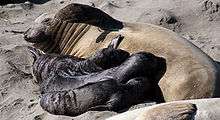
After arrival on shore, males fast for three months, and females fast for five weeks during mating and when nursing their pups. The gestation period is about 11 months. Sometimes, a female can become very aggressive after giving birth and will defend her pup from other females.[24] Such aggression is more common in crowded beaches.[24] While most females nurse their own pups and reject nursings from alien pups, some do accept alien pups with their own.[20][23] An orphaned pup may try to find another female to suckle and some are adopted, at least on Año Nuevo Island.[20][23] Pups nurse about four weeks and are weaned abruptly before being abandoned by their mother, who heads out to sea within a few days. Left alone, weaned pups will gather into groups and stay on shore for 12 more weeks. The pups learn how to swim in the surf and eventually swim farther to forage. Thus, their first long journey at sea begins.
Elephant seals communicate though various means. Males will threaten each other with the snort, a sound caused by expelling air though their probosces, and the clap-trap, a loud, clapping sound comparable to the sound of a diesel engine.[25] Pups will vocalize when stressed or when prodding their mothers to allow them to suckle. Females make an unpulsed attraction call when responding to their young, and a harsh, pulsed call when threatened by other females, males or alien pups.[25] Elephant seals produce low-frequency sounds, both substrate-borne and air-borne. These sounds help maintain social hierarchy in crowded or noisy environments and reduce energy consumption when fasting.[25]
History and status
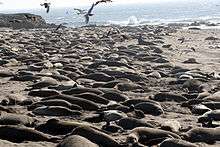
Beginning in the 18th century, northern elephant seals were hunted extensively, almost to extinction by the end of the 19th century,[1] being prized for oil made from their blubber, and the population may have fallen as low as only 20 individuals.[1] In 1874, Charles Melville Scammon recorded in Marine Mammals of the Northwestern Coast of America, that an 18-ft-long bull caught on Santa Barbara Island yielded 210 gallons of oil.[26] They were thought to be extinct in 1884 until a remnant population of eight individuals was discovered on Guadalupe Island in 1892 by a Smithsonian expedition, who promptly killed seven of the eight for their collections.[27] The elephant seals managed to survive, and were finally protected by the Mexican government in 1922. Since the early 20th century, they have been protected by law in both Mexico and in the United States. Subsequently, the U.S. protection was strengthened after passage of the Marine Mammal Protection Act of 1972, and numbers have now recovered to over 100,000.
Nevertheless, a genetic bottleneck exists in the existing population, which could make it more susceptible to disease and pollution.[28][29] In California, the population is continuing to grow at around 6% per year, and new colonies are being established; they are now probably limited mostly by the availability of haul-out space. Their breeding was probably restricted to islands, before large carnivores were exterminated or prevented from reaching the side of the ocean.[30] Numbers can be adversely affected by El Niño events and the resultant weather conditions, and the 1997–98 El Niño may have caused the loss of about 80% of that year's pups. Presently, the northern elephant seal is protected under the federal Marine Mammal Protection Act and has a fully protected status under California law.
Populations of rookery sites in California have increased during the past century.[1] At Año Nuevo State Park, for example, no individuals were observed whatsoever until 1955; the first pup born there was observed in the early 1960s. Currently, thousands of pups are born every year at Año Nuevo, on both the island and mainland. The growth of the site near San Simeon has proved even more spectacular; no animals were there prior to 1990. Currently, the San Simeon site hosts more breeding animals than Año Nuevo State Park during winter season.
References
- 1 2 3 4 5 Campagna, C. (2008). "Mirounga angustirostris". IUCN Red List of Threatened Species. Version 2008. International Union for Conservation of Nature. Retrieved 28 January 2009.
- ↑ Beer, Encyclopedia of North American Mammals: An Essential Guide to Mammals of North America. Thunder Bay Press (2004), ISBN 978-1-59223-191-1.
- ↑ Mirounga angustirostris. Northern Elephant Seal. Smithonian National Museum of Natural History
- ↑ Novak, R. M. (1999). Walker's Mammals of the World. 6th edition. Johns Hopkins University Press, Baltimore. ISBN 0-8018-5789-9
- ↑ Thornton SJ, Hochachka PW (2004). "Oxygen and the diving seal" (PDF). Undersea Hyperb Med. 31 (1): 81–95. PMID 15233163. |lastauthoramp=yes
- ↑ Stewart BS, Yochem PK, Huber HR, DeLong RL, Jameson RJ, Sydeman WJ, Allen SG, Le Boeuf BJ (1994) "History and present status of the Northern elephant seal population". In: Le Boeuf BJ, Laws RM (eds) Elephant Seals: Population Ecology, Behavior, and Physiology. University of California Press, Berkeley, CA, pp. 29–48, ISBN 0520083644.
- 1 2 3 U.S. Pacific Marine Mammal Stock Assessments: 2007 (NMFS-SWFSC-414). (PDF) . Retrieved on 2011-09-15.
- ↑ Hodder J, Brown RF, Cziesla C (1998). "The northern elephant seal in Oregon: A pupping range extension and onshore occurrence". Marine Mammal Science. 14: 873–881. doi:10.1111/j.1748-7692.1998.tb00772.
- ↑ Elephant Seal birth of baby ninene. Racerocks.com. Retrieved on 2011-09-15.
- 1 2 3 4 5 6 7 8 9 10 Le Boeuf, B.; D. Crocker; D. Costa; S. Blackwell; P. Webb (2000). "Foraging ecology of northern elephant seals". Ecological Monographs. 70 (3): 353–382. doi:10.1890/0012-9615(2000)070[0353:feones]2.0.co;2. JSTOR 2657207.
- 1 2 Condit, R. & Le Boeuf, B.J. (1984). "Feeding Habits and Feeding Grounds of the Northern Elephant Seal". J. Mammal. 65 (2): 281–290. doi:10.2307/1381167.
- ↑ http://www.fpir.noaa.gov/Library/PRD/ESA%20Consultation/Marianas_Species_List_Jan_2015.pdf
- ↑ http://niijima.jp/mt/archives/2011/03/post_326.html
- ↑ http://www9.ocn.ne.jp/~dorsals/honyu/azarasi.htm. retrieved on 14-05-2015
- ↑ Kuznetsov V.B. (2004). "Marine Mammals of the Holarctic" (PDF).
|chapter=ignored (help) - ↑ Morejohn, G.V. & Beltz, D.M. (1970). "Contents of the stomach of an elephant seal". Journal of Mammalogy. 51 (1): 173–174. doi:10.2307/1378554.
- ↑ Le Beouf, Burney J.; Richard M. Laws (1994). Elephant Seals: Population ecology, behavior, and physiology. University of California Press. pp. 213–214. ISBN 978-0-520-08364-6.
- ↑ Outdoor. GrindTV. Retrieved on 2014-03-18.
- ↑ White Sharks – Carcharodon carcharias. Pelagic Shark Research Foundation.
- 1 2 3 4 Riedman, M.L. & Le Boeuf, B.J. (1982). "Mother-pup separation and adoption in northern elephant seals". Behav. Ecol. Sociobiol. 11 (3): 203–213. doi:10.1007/BF00300063. JSTOR 4599535.
- 1 2 3 4 Le Boeuf BJ (1972). "Sexual behavior in the Northern Elephant seal Mirounga angustirostris". Behaviour. 41 (1): 1–26. doi:10.1163/156853972X00167. JSTOR 4533425. PMID 5062032.
- 1 2 3 Le Boeuf BJ (1974). "Male-male competition and reproductive success in elephant seals". Am. Zool. 14: 163–176. doi:10.1093/icb/14.1.163.
- 1 2 3 Le Boeuf BJ; Whiting, R. J.; Gantt, R. F. (1972). "Perinatal behavior of northern elephant seal females and their young". Behaviour. 43 (1): 121–156. doi:10.1163/156853973x00508. JSTOR 4533472. PMID 4656181.
- 1 2 Christenson, T. E. & Le Boeuf, B. J. (1978). "Aggression in the Female Northern Elephant Seal, Mirounga angustirostris". Behaviour. 64 (1/2): 158–172. doi:10.1163/156853978X00495. JSTOR 4533866.
- 1 2 3 Steward, B. S.; Huber, H. R. (1993). "Mirounga angustirostris" (PDF). Mammalian Species. 449: 1–10. doi:10.2307/3504174.
- ↑ Scammon, Charles Melville (2007). The marine mammals of the northwestern coast of North America: together with an account of the American whale-fishery. Heyday Books. p. 132. ISBN 978-1-59714-061-4. Retrieved 5 September 2011.
- ↑ Busch, Briton Cooper (1987). The War Against the Seals: A History of the North American Seal Fishery. McGill-Queen's Press. p. 187. ISBN 978-0-7735-0610-7.
- ↑ Hoelzel, A. R.; Fleischer, R. C.; Campagna, C.; Le Boeuf, B. J. & Alvord, G. (2002). "Impact of a population bottleneck on symmetry and genetic diversity in the northern elephant seal". Journal of Evolutionary Biology. 15 (4): 567–575. doi:10.1046/j.1420-9101.2002.00419.x.
- ↑ Weber, D. S.; Stewart, B. S.; Garza, J. C. & Lehman, N. (2000). "An empirical genetic assessment of the severity of the northern elephant seal population bottleneck". Current Biology. 10 (20): 1287–1290. doi:10.1016/S0960-9822(00)00759-4. PMID 11069110.
- ↑ Le Boeuf, Burney J.; Kaza, Stephanie, eds. (1981). "Ch. 7 "Mammals"". The Natural History of Ano Nuevo. Boxwood Press. ISBN 0910286779.
External links
| Wikimedia Commons has media related to Mirounga angustirostris. |
- Marine Mammal Center – Northern elephant seal
- SCS: Northern elephant seal
- Elephant Seal Research Group
- Elephant seals – Earthguide
- Voices in the Sea - Sounds of the Northern elephant Seal
